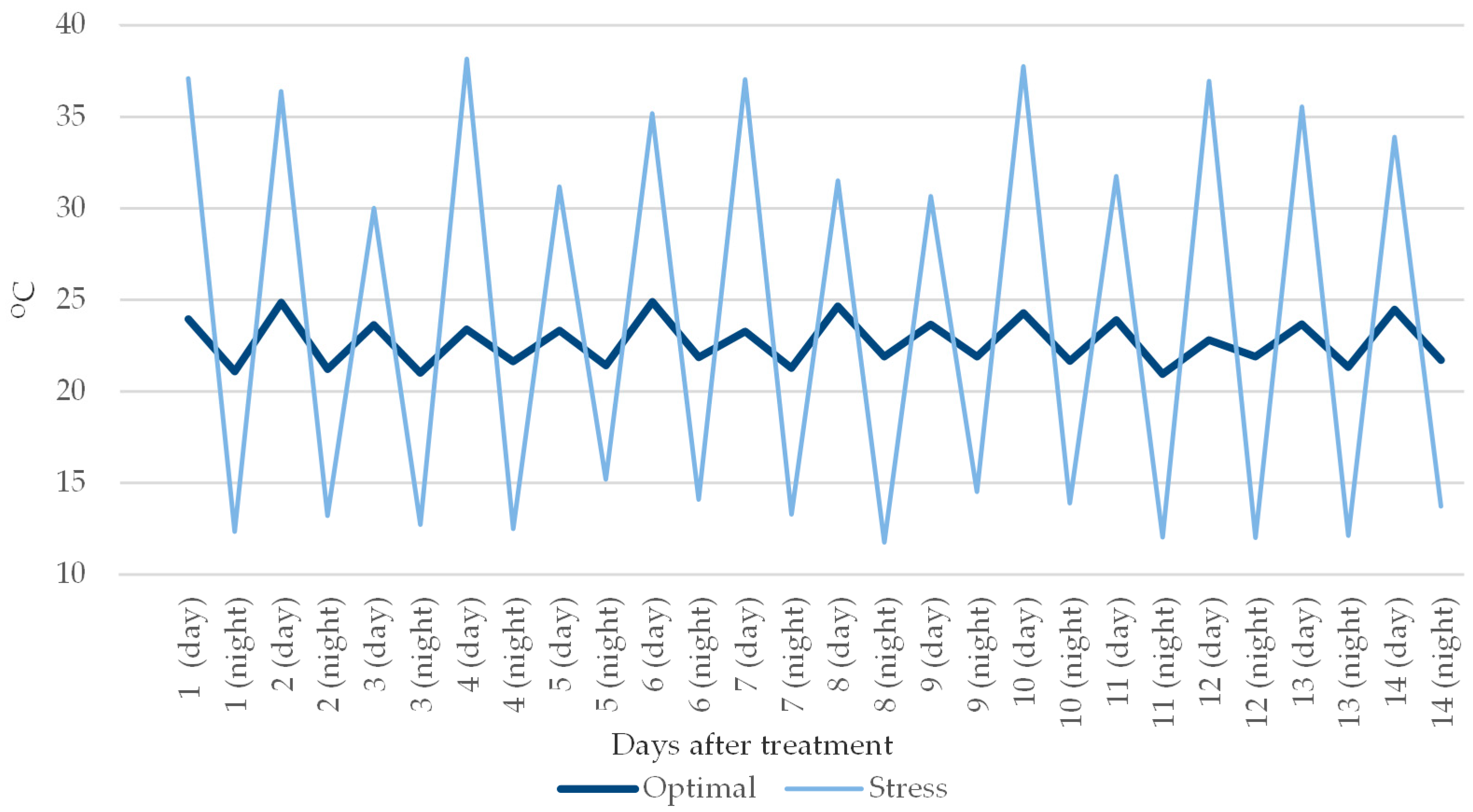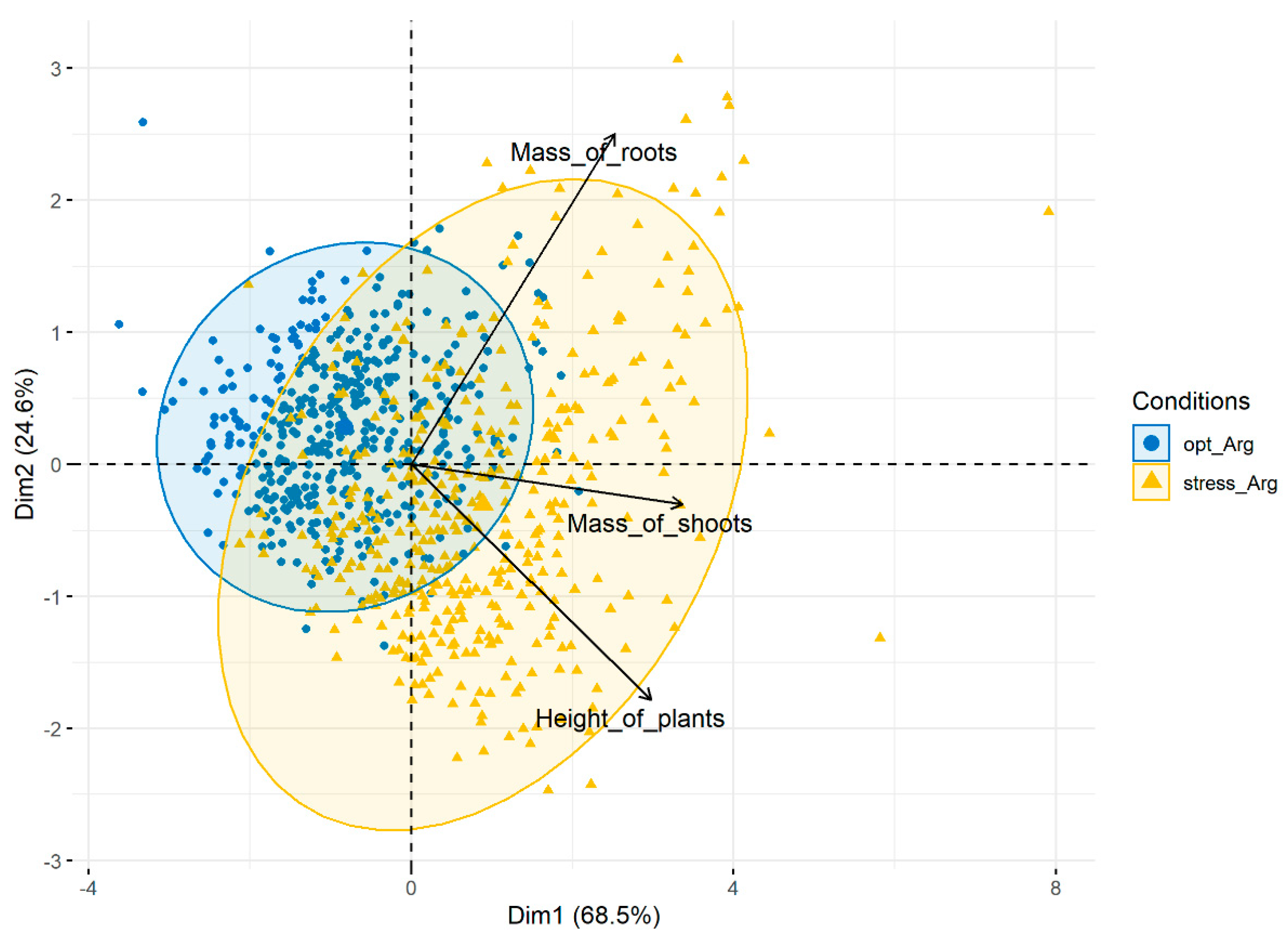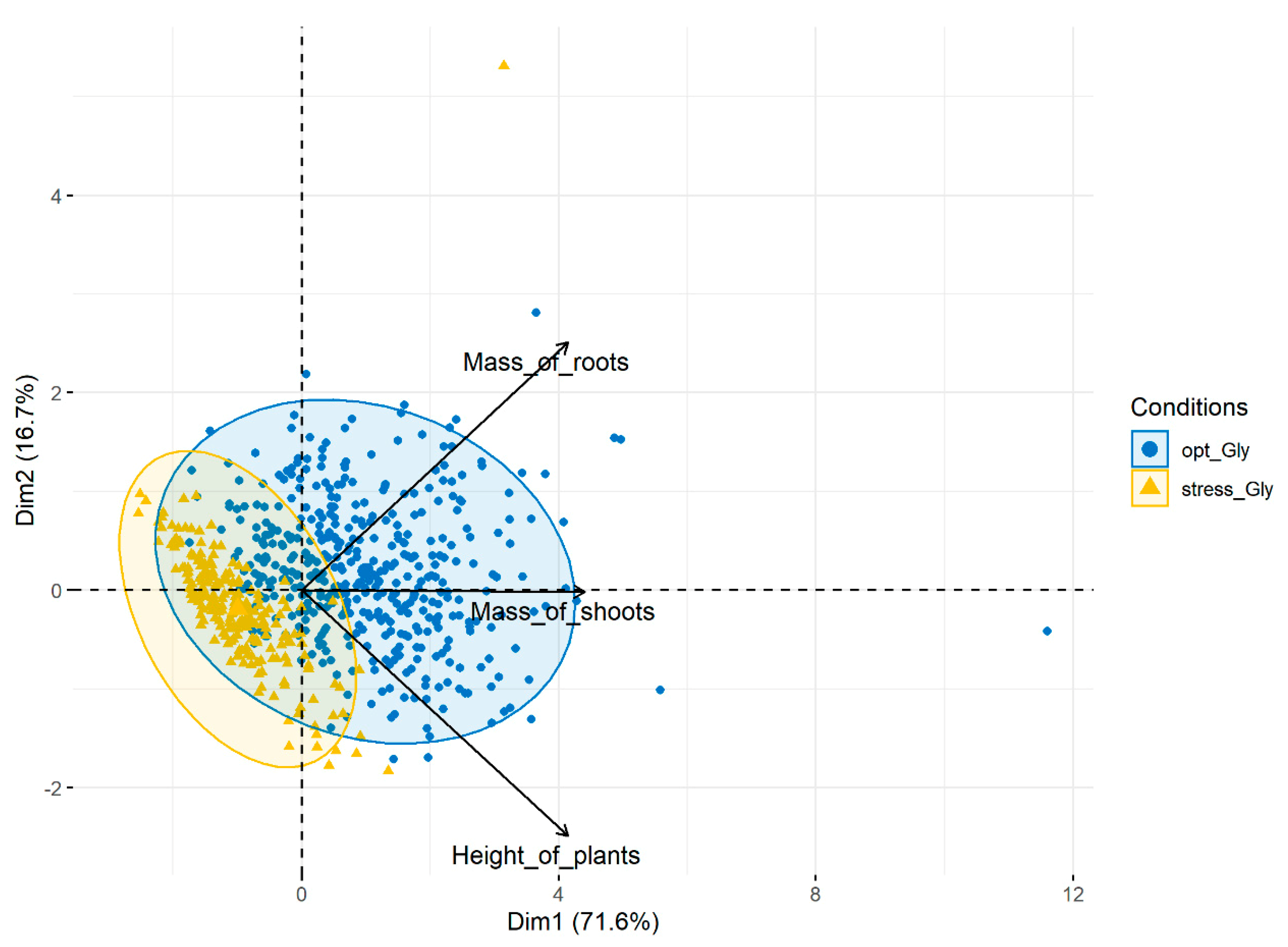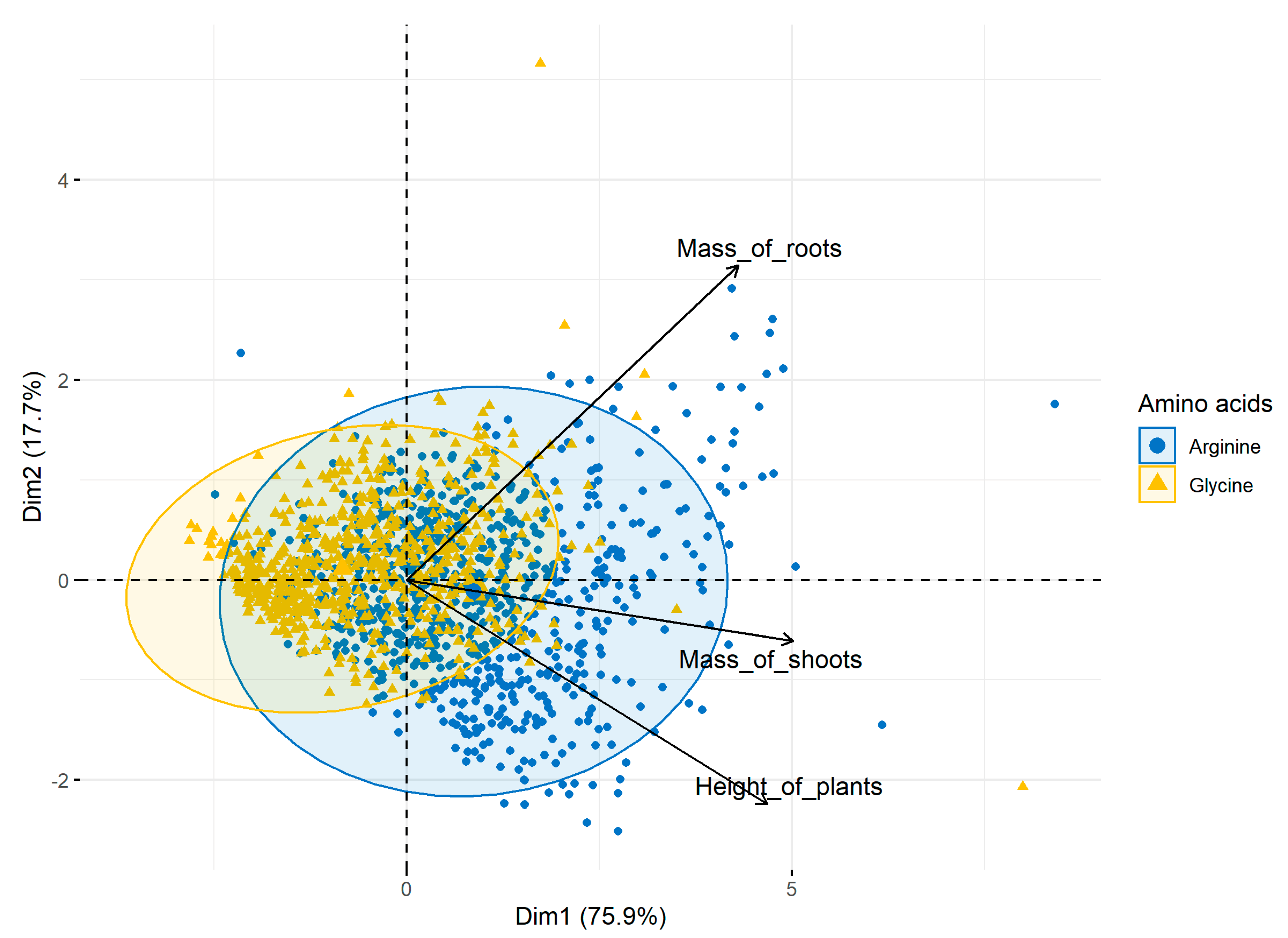1. Introduction
Temperature stress is suggested as a primary growth-limiting factor for most crop plants. It can disturb ‘yield potential’, which refers to the productivity of a plant when resource capture and utilisation are not limiting, whereas ‘stress’ is defined as a factor that reduces either resource capture or utilisation [
1,
2]. It has been proven that the adverse effect of thermal stress conditions largely depends on its severity and duration [
3]. Prolonged and even a transitional temperature stress interferes with many metabolic processes in plants. These are mostly evident in the cellular membranes and enzymes, as well as in the whole photosynthetic system.
Elevated temperatures cause a state of dehydration by the rapid loss of water from the plant’s surface and reducing the chances of survival, and of further regular growth and development [
4]. Heat stress is a complex function of the intensity, duration, and rate of increase in temperature. Chilling stress also adversely affects morphological, physiological, biochemical, and molecular changes in plants [
5,
6,
7]. Most of the injury to plants that is caused by chilling stress is associated with oxidative damage at the cellular level. Additionally, chilling seems to be the major challenging stress among abiotic stresses, because it limits both the productivity and geographical distribution of many crops [
3,
8,
9]. A rise and drop in temperature results in protein unfolding and affects multimetric peptide structures. Among the biochemical changes in plants that are caused by temperature stress, and the most conspicuous of these, is the accumulation of reactive oxygen species (ROS) [
9,
10,
11,
12,
13]. The overproduction of ROS within the cellular environment is determined by the antioxidant system and various compatible solutes can effectively take part in plant stress tolerance [
14,
15,
16]. Stress conditions, such as salinity, UV radiation, drought, heavy metals, and extreme temperatures, disturb the defence mechanisms in plants, which leads to ROS accumulation inside the cells. Singlet oxygen (
1O
2), superoxide (O
2−), hydrogen peroxide (H
2O
2), and hydroxyl radical (HO
.) are toxic to plants and damage proteins, lipids, carbohydrates, and DNA resulting, in extreme cases, in cell death. Excessive ROS accumulation as a result of various environmental stresses is the main reason for agricultural yield loss worldwide [
17,
18]. The exogenous application of different antioxidants in plants might be helpful in minimizing the harmful effects of stress. Many substances are useful in the way that they provide crucial protection against oxidative damage and, many of them, when applied in small quantities, are also able to enhance the plants’ ability to assimilate applied nutrients, or provide benefits to plant development [
19]. Biostimulating effect is widely described in many scientific papers on substances such as i.e. -tocoferol, polyamines, L-ascorbate, glutathione, glycine betaine, putrescine, glycine, spermine, spermidyne, salicylic acid, hydrogen peroxide, silicone, alginic acid, polyphenols, and trehalose [
3,
7,
8,
15,
19,
20,
21,
22,
23,
24,
25,
26,
27,
28].
One of the main categories of biostimulants is protein hydrolysates and other N-containing compounds. This group includes free amino acids. In general, protein oxidation by ROS is irreversible, but this does not apply to proteins that are rich in sulphur-containing amino acids (arginine, histidine, proline, threonine, tryptophan). These amino acids, apart from the thiol (-SH) group, also contain a carbonyl group, which inhibits the effects of proteolytic attack [
29]. Thus, it has been demonstrated that exogenous application of certain amino acids allows for plants to survive unfavourable stress conditions, and stimulates their further, undisturbed growth and development [
15,
19,
30,
31,
32,
33,
34]. Some studies have confirmed that, in plants, the most functionally diverse amino acid and a precursor for biosynthesis of nitric oxide and polyamines is L-Arginine [
13,
14,
16]. Polyamines and their precursor arginine have been implicated as vital modulators in a variety processes in higher plants, such as growth, physiology, and development, as well as in plant response to various stress factors. It has also been recorded that both endogenous and exogenous arginine play a role in plant stress response [
6,
7,
35,
36]. Glycine is the simplest amino acid in nature and is one of the most abundant free amino acids in soil. It is more rapidly taken up by plants as compared to other amino acids. However, there have been far fewer studies on the role of the exogenous application of Glycine on plant’s growth [
24].
Crop species will achieve their highest yields, with the lowest risk of failure, when they are cultivated as close as possible to the specific temperature optimum for each of the plants’ developmental stages during the growing season [
37]. Maize is a warm season crop and the third most important cereal after wheat and rice. It requires a relatively high temperature optimum (30–35 °C) for growth and development. In climates with mid-summer, the optimum growth in maize crop varies between 21 °C and 27 °C. The temperature below 12–15 °C can damage the young plant, mostly by growth and development inhibition. Maize plants are the most sensitive to chilling at early growth stages [
8,
38,
39]. It has been proven that free amino acid contents were decreased with increasing stress in maize plants [
33].
The objective of the present study was to evaluate the response of maize grown under optimal and stress (rising and dropping) temperature to L-Aginine and Glycine application. The amino acids that were used in the study differed considerably in terms of their structure and function: L-Arg is a precursor of polyamines, and Gly, which is a chlorophyll precursor, enhances photosynthesis. In the study, it was hypothesized that the exogenously applied amino acids would alleviate the adverse effects of temperature stress on maize growth and the mass of shoots and roots. There have been no reports on the foliar application of L-Arginine and Glycine under fluctuating thermal conditions. Moreover, the scientific literature lacks publications regarding the effect of these amino acids on such an economically important plant as maize.
2. Materials and Methods
In the Institute of Plant Protection–National Research Institute in Poznan (Poland), four cycles of laboratory and glasshouse experiments were conducted. They aimed at assessing the effect of amino acids on the initial growth of maize. The fodder cultivar Wiarus, chosen for the experiments, was characterized by very good early vigour that is based on the breeding tests (Plant Breeding Company Ltd. Smolice). The experiments involved the application of two amino acids: L-Arginine and Glycine.
2.1. Characteristics of Amino Acids
L-Arginine (L-Arg) was used as L-Arginine preparation (High Purity Grade); ARG005.500; C2H14N4O2; MW 174.20; Purity min. 98.5%; Residue on ignition: <0.3%; Heavy metals: <0.0015; Sulfate (SO4) < 0.03%; Chloride < 0.05%; Iron < 0.003%; Manufacturer BioShop® Canada Inc., Burlington, ON, Canada.
Glycine (Gly) was used as Glycine preparation (Biotechnology Grade); GLN0001.500; C2H5NO2; MW 75.07; Purity min. 99.0%; Solubility (10% water): clear/colourless; Heavy metals (as Pb) < 0.002%; DNase, ENase and Protease activity: non-detected; and, Manufacturer BioShop® Canada Inc.
2.2. Laboratory Experiments
Laboratory experiments were preliminary trials that were undertaken to confirm a useful selection of amino acid concentrations for glasshouse experiments. The laboratory experiments used a commercial toxicity bioassay—PhytotoxkitTM test (Phytotoxkit™ 2004, MicroBioTests Inc, Gent, Belgium). The test was based on measuring the germination and growth of the plant radicle after three days of exposure to experimental treatments. The Phytotoxkit makes use of flat and shallow transparent test plates composed of two compartments, with the lower one containing soil saturated to water-holding capacity. Maize seeds were soaked for 24 h in distilled water solutions of L-Arginine and Glycine. Each amino acid was applied in ten concentrations: 0.006 mM, 0.003 mM, 0.06 mM, 0.2 mM, 0.3 mM, 0.6 mM, 2 mM, 3 mM, 6 mM, and 9 mM. There was also control treatment involving seeds soaked in pure distilled water. In the next phase, the seeds were transferred to plastic test plates. In the lower compartment of each plate, 90 mL of quartz sand (Ø 0.6–0.8 mm) and 50 mL of water to obtain 100% water saturation of the sand were applied. The experiment was carried out in four replications. Ten seeds (per replicate) were positioned at equal distances near the middle ridge of each test plate and in two rows on a black filter paper. The test plates were closed and placed vertically in a holder and incubated in dark conditions at 25 °C for three days. After the incubation period, digital pictures were taken and both the length of the radicles (main root) and the number of lateral roots were estimated while using a software image tool 3.0 UTHSCSA.
2.3. Glasshouse Experiments
Maize seeds were sown in plastic pots (17 m
−2 diameter). Horticultural soil mixed with sand in a ratio of 3:1 was used as the substrate for the experiments. The soil contained 1.89% organic matter and had a pH of 6.2. Twenty seeds were planted in each pot. After emergence, the plants were thinned to 10 plants per pot. Amino acids were applied to three–four leaves of plants (the growth stage V3–V4). The experiment involved 11 combinations: 10 sprayed with amino acid solutions and the control (distilled water). The experiments were carried out in three series and eight replications (88 pots for each series). The pots were randomly allocated and the series followed one after the other. Ten water solutions of each amino acid (L-Arginine and Glycine) were tested at concentrations of 0.006 mM, 0.003 mM, 0.06 mM, 0.2 mM, 0.3 mM, 0.6 mM, 2 mM, 3 mM, 6 mM, and 9 mM. The application was performed with a greenhouse sprayer equipped with a TeeJet TT 11002 spray nozzle at a pressure of 0.3 MPa. In the experiments, the greenhouse conditions included a temperature of 20–22 °C (night) and 23–25 °C (day) and a 16/8-h day-night photoperiod with a light intensity of ≈150 μmol·m
−2·s
−1 and a relative humidity of 60–70%. After spraying, all of the plants were divided into two groups and one group (44 pots) was moved to a chamber where the temperature was subject to daily fluctuations. The temperature oscillated between 12–15 °C (night) and 30–38 °C (day) and the relative humidity varied from 50% to 85%.
Figure 1 presents the mean temperature in all of the experiment series. Other experimental conditions (light, water supply) remained unchanged. The temperature measurements were performed while using a HOBO Temperature/Relative Humidity Data Logger with an accuracy of ±0.7 °C. The remaining plants were kept in optimal conditions for growth and development. After 14 days, the height and the mass of shoots and roots of plants from optimal and stressed conditions were estimated (at the growth stage V8).
2.4. Statistical Analysis
The results of the laboratory experiments were subjected to statistical analysis in accordance with the two-factor ANOVA model by means of FR–ANALWAR–4.3 software. The significance of differences was assessed with Tukey’s confidence half-interval at a significance level of
p = 0.05. All statistical analyses for the greenhouse experiments were carried out in R version 3.6.2 [
40].
4. Discussion
Research on the effects of exogenous amino acid application on plants focuses on three methods of application: seed, foliar, and culture medium treatments. The aim of our study, which also involved seed pre-treatment, was mainly to determine the concentration of amino acids for further research based on the length and number of lateral roots. However, the study does not precisely indicate the likely course of the further growth and development of maize obtained from seeds soaked in the solutions of the amino acids analysed. Nevertheless, numerous studies by other authors indicate that pre-treating seeds with amino acids may positively influence the subsequent development of plants, especially under stress conditions. In a study that was conducted by Rasheed et al. [
41], seed pre-treatments with the amino acid proline proved beneficial in improving the germination and growth of seedlings under optimal and sub-optimal conditions. Arginine pre-treatment significantly increased the germination percentage and germination rate of
Pistacia vera in low temperature conditions as compared to untreated samples, according to Nasibi et al. [
42]. In our studies with soaked seeds, where there were no stress conditions, it was shown that the seeds pre-treated with amino acids germinated at the same rate as the seeds from the control, and both L-Arginine (L-Arg) and Glycine (Gly) increased the length of the root and lateral roots. However, in the case of L-Arg, the average amino acid concentrations were 0.2 mM, 0.3 mM, and 0.6 mM. In the case of Gly, both the lowest (0.006 mM to 0.06 mM) and the very high (2 mM to 9 mM) concentrations were good for the root system. Moreover, Nejadalimoradi et al. [
16] showed that pre-treatment Arg with concentrations 1 mM and 5 mM significantly increased the total biomass of sunflower plants. The results of our research are consistent with those that were obtained by Zeid et al. [
43], who observed that arginine pre-treatment promoted the growth parameters of bean plants. Nejadalimoradi et al. [
16] showed that pre-treatment Arg 1 mM and 5 mM increased the length of plants, but that the greatest plant height was obtained in control plants that were pre-treated with arginine 1mM. Sotiropoulos et al. [
21], who studied the effectiveness of increasing concentrations of arginine of the culture medium, observed that the number of shoots of apple per explant increased.
In our study, while the differences in the effects of the two amino acids on the germination and growth of radicle were small and only concerned the concentrations being tested, significant differences appeared after foliar application and following the introduction of the stress factor. For plants growing under optimal conditions, a beneficial effect of L-Arg was noted on both the mass of shoots and roots, while, for plants growing under stress, a beneficial effect of L-Arg was only noted on the mass of roots. However, this was a significant increase of up to 100%. What is undoubtedly interesting about the results of our study is that L-Arg did not have any impact on the height and biomass of the maize growing under stress conditions, although other researchers observed a contrary effect. A case in point is a study by Hassanein et al. [
22], who proved that foliar spraying of wheat shoots with arginine and putrescine (1.25 and 2.5 mM) before temperature significantly increased the fresh and dry mass and water content and arginine treatments were more effective than putrescine in this respect. Yagi and Al-Abdulkareem [
44], who presumed that arginine might have helped in the synthesis of polyamines, which are associated with the adaptation to stressful environments, also observed the beneficial effect of Arginine on plants that were exposed to stress factors. The application of arginine before exposing wheat plants to high stress temperature increased the amino acids while decreasing the NH4+ (very toxic) contents when compared with the untreated plants that were only exposed to high temperature [
41]. The obtained data were supported by Kesba [
45], who reported that L-arginine treatments stimulated plant growth (grape) by enhancing the levels of arginine, aspartic, glutamic, proline, and methionine. It is difficult to compare our research with studies by other authors, as it has been proven that under stress conditions accumulation of polyamines, whose precursors include L-Arginine, depends on the plant species or even cultivar. In some species, polyamine is produced in response to stress, whereas, in others, there is not even a decrease in endogenous polyamines [
14,
46]. Likewise, every species may react differently to the amount of the amino acid supplied. Moreover, the dose—concentration of the amino acid—may have various effects, depending on the plant development phase at the time of application.
Nassar et al. [
47] found that increasing concentrations of Arg significantly increased the growth parameters and promoted the growth and increased the fresh and dry mass in beans. In our study, no linear relationship between the increased concentrations and the increase in the trait examined was observed and this concerned both Arg and Glycine. Our study showed that the impact on the height of maize treated with L-Arg was small, regardless of the conditions. The differences in plant height either ranged from a few to several percent or the height was the same as in the control plants. The most beneficial effect on this trait was L-Arg concentrations from 0.3 mM and higher. However, Qados [
35] reported that spraying mung bean with arginine 1.25, 2.5, and 5 mM significantly reduced the plant height of mung bean plants and increasing the arginine concentration gradually reduced the plant height. Mohseni et al. [
48] recorded that the exogenous application of Arginine at 0.5 mM also affected the size of the fruit of strawberry and increased the number of achenes of primary and secondary fruit of that plant.
The present study revealed that Gly had little effect on plants growing under optimal conditions. On the other hand, when applied at certain concentrations under stress conditions, it even had a negative effect on the weight of maize shoots and roots. These results support the findings of Yang et al. [
24], who reported that Glycine significantly reduced the fresh and aboveground weights when compared to control lettuce, but that the highest exogenous concentration of glycine (18 mM) significantly increased the total polyphenol content of the lettuce leaves. Other researchers note that the effect of Gly might be dependent on the nitrogen content of the medium. Forsum et al. [
49] point out that, when compared to nitrogen deficiency, exogenous glycine supply increases the production of biomass in Arabidopsis plants. The appropriate concentration of glycine significantly enhanced the levels of antioxidants, as compared to lettuce supplied with nitrate [
24]. In addition, although this does not come within the scope of our study, there are studies showing that the effect of amino acids on the growth of plants might vary, depending on the individual susceptibility to the variety to a stress factor [
50].
The research described points to a non-consistent reaction of maize to the amino acids studied. Even though the two amino acids are essential to plants, they perform different functions. Arginine is involved in the synthesis of polyamines, whose anti-oxidative effect has been confirmed in numerous scientific studies. Glycine, on the other hand, as the main amino acid in the synthesis of chlorophyll, plays an important role in photosynthesis. However, it is arginine that serves as the main focus in most of the scientific reports on the effect of amino acids on plants under stress (salt, temperature, water). In our study, we wanted to demonstrate that exogenous glycine application might also significantly impact the growth and development of maize (although the impact was mainly negative). We also attempted to analyse the effect of amino acids in a large number of concentrations. This proved fruitful, as we showed significant differences in the effects of L-Arg and Gly, depending on their concentration.
This study might also have a practical application. There are numerous products on the market (fertilizers, biostimulators) that contain a complex of amino acids, including L-Arg and Gly, intended for use in e.g. maize, especially under conditions of expected stress. Basic research on the effects of different amino acids on arable crops might contribute considerably to the better use of these products or to the verification of the need to use them in the current composition.











